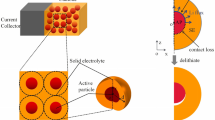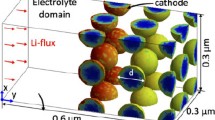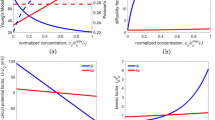Abstract
The interfacial instability due to periodic volume expansion of electrodes in the charging and discharging process directly affects the contact performance and interface impedance between the electrodes and the solid-state electrolyte (SSE). The existing work has studied the local stress state behavior on a single spatial scale or only focused on the interfacial influence of electrochemical characteristics at a specific time. In this paper, a semi-analytical method-based chemoelastic contact model was developed to study the evolution behavior of the cathode/SSE interface, and the stress and displacement fields subjected to contact forces were calculated by means of the discrete convolution-fast Fourier transform algorithm. The interface evolution subjected to mechanical pressure was analyzed for the local influence of the stress at one position at a specified time on the contact behavior at the present time and position, and the global influence of those at other positions at a later time. Based on this model, the mechanical-chemical coupling effect of lithium intercalation on interface stability was quantitatively studied, and the mechanism of enhancing interfacial contact stability by mechanical load was further explored. The results show that a larger current causes the contact toward the center, while a larger mechanical force leads to a smaller pressure peak. With the increase in mechanical force, the compressive stress in the contact area decreases significantly, while the tensile stress outside the contact area increases slightly. Based on the model results, a transition map was constructed with bonder equation (\(P/I = 25 \rm MPa \cdot \rm cm ^2 / \rm mA\)) to define whether an interfacial contact is stable or not. Quantitatively, applying a mechanical pressure \(P/I > 25 \rm MPa \cdot \rm cm ^2 / \rm mA\) can maintain a stable interfacial contact between the SSE and the cathode. The proposed model provides a theoretical basis in the chemomechanics view for the understanding of using pressure to suppress diffusion-induced contact instability in lithium batteries.










Similar content being viewed by others
Availability of Data and Materials
All data generated or analyzed during this study are included in this published article.
References
Sun C, Liu J, Gong Y, Wilkinson DP, Zhang J. Recent advances in all-solid-state rechargeable lithium batteries. Nano Energy. 2017;33:363–86.
Gao Z, Sun H, Fu L, Ye F, Zhang Y, Luo W, et al. Promises, challenges, and recent progress of inorganic solid-state electrolytes for all-solid-state lithium batteries. Adv Mater. 2018;30(17):1705702.
Randau S, Weber DA, Kötz O, Koerver R, Braun P, Weber A, et al. Benchmarking the performance of all-solid-state lithium batteries. Nat Energy. 2020. https://doi.org/10.1038/s41560-020-0565-1.
Wenzel S, Leichtweiss T, Krüger D, Sann J, Janek J. Interphase formation on lithium solid electrolytes—an in situ approach to study interfacial reactions by photoelectron spectroscopy. Solid State Ion. 2015;278:98–105.
Sharafi A, Yu S, Naguib M, Lee M, Ma C, Meyer HM, et al. Impact of air exposure and surface chemistry on Li-Li7La3Zr2O12 interfacial resistance. J Mater Chem A. 2017;5(26):13475–87.
Shen Y, Zhang Y, Han S, Wang J, Peng Z, Chen L. Unlocking the energy capabilities of lithium metal electrode with solid-state electrolytes. Joule. 2018;2(9):1674–89.
Zhang W, Schröder D, Arlt T, Manke I, Koerver R, Pinedo R, et al. (Electro) chemical expansion during cycling: monitoring the pressure changes in operating solid-state lithium batteries. J Mater Chem A. 2017;5(20):9929–36.
Nie K, Hong Y, Qiu J, Li Q, Yu X, Li H, et al. Interfaces between cathode and electrolyte in solid state lithium batteries: challenges and perspectives. Front Chem. 2018;6:616.
Krauskopf T, Hartmann H, Zeier WG, Janek J. Toward a fundamental understanding of the lithium metal anode in solid-state batteries—an electrochemo-mechanical study on the garnet-type solid electrolyte Li6.25Al0.25La3Zr2O12. ACS Appl Mater Interfaces. 2019;11(15):14463–77.
Wang MJ, Choudhury R, Sakamoto J. Characterizing the Li-solid-electrolyte interface dynamics as a function of stack pressure and current density. Joule. 2019;3(9):2165–78.
Doux J-M, Yang Y, Tan DH, Nguyen H, Wu EA, Wang X, et al. Pressure effects on sulfide electrolytes for all solid-state batteries. J Mater Chem A. 2020;8(10):5049–55.
Doux JM, Nguyen H, Tan DH, Banerjee A, Wang X, Wu EA, et al. Stack pressure considerations for room-temperature all-solid-state lithium metal batteries. Adv Energy Mater. 2020;10(1):1903253.
Tian H-K, Qi Y. Simulation of the effect of contact area loss in all-solid-state Li-ion batteries. J Electrochem Soc. 2017;164(11):E3512–21.
Monroe C, Newman J. Dendrite growth in lithium/polymer systems a propagation model for liquid electrolytes under galvanostatic conditions. J Electrochem Soc. 2003;150(10):A1377–84.
Monroe C, Newman J. The effect of interfacial deformation on electrodeposition kinetics. J Electrochem Soc. 2004;151(6):A880–6.
Ahmad Z, Viswanathan V. Stability of electrodeposition at solid-solid interfaces and implications for metal anodes. Phys Rev Lett. 2017;119(5):056003.
Barai P, Higa K, Srinivasan V. Effect of initial state of lithium on the propensity for dendrite formation: a theoretical study. J Electrochem Soc. 2017;164(2):A180–9.
Barai P, Higa K, Ngo AT, Curtiss LA, Srinivasan V. Mechanical stress induced current focusing and fracture in grain boundaries. J Electrochem Soc. 2019;166(10):A1752–62.
Zhang X, Wang QJ, Harrison KL, Jungjohann K, Boyce BL, Roberts SA, et al. Rethinking how external pressure can suppress dendrites in lithium metal batteries. J Electrochem Soc. 2019;166(15):A3639–52.
Zhang X, Wang QJ, Harrison KL, Roberts SA, Harris SJ. Pressure-driven interface evolution in solid-state lithium metal batteries. Cell Rep Phys Sci. 2020;1(2):100012.
Zhang X, Wang QJ, Peng B, Wu Y. Pressure-driven and creep-enabled interface evolution in sodium metal batteries. ACS Appl Mater Interfaces. 2021;13(22):26533–41.
Xu R, Yang Y, Yin F, Liu P, Cloetens P, Liu Y, et al. Heterogeneous damage in Li-ion batteries: experimental analysis and theoretical modeling. J Mech Phys Solids. 2019;129:160–83.
Sheng Y, Fell CR, Son YK, Metz BM, Jiang J, Church BC. Effect of calendering on electrode wettability in lithium-ion batteries. Front Energy Res. 2014;2:56.
Meyer C, Bockholt H, Haselrieder W, Kwade A. Characterization of the calendering process for compaction of electrodes for lithium-ion batteries. J Mater Process Technol. 2017;249:172–8.
Zhang ZH, Zhao YR, Chen SJ, Xie DJ, Yao XY, Cui P, et al. An advanced construction strategy of all-solid-state lithium batteries with excellent interfacial compatibility and ultralong cycle life. J Mater Chem A. 2017;5(32):16984–93.
Zhao Y, Stein P, Bai Y, Al-Siraj M, Yang Y, Xu B-X. A review on modeling of electro-chemo-mechanics in lithium-ion batteries. J Power Sources. 2019;413:259–83.
Zhang F, Huang Q-A, Tang Z, Li A, Shao Q, Zhang L, et al. A review of mechanics-related material damages in all-solid-state batteries: mechanisms, performance impacts and mitigation strategies. Nano Energy. 2020;70:104545.
Zhu X, Chen Y, Chen H, Luan W. The diffusion induced stress and cracking behaviour of primary particle for Li-ion battery electrode. Int J Mech Sci. 2020;178:105608.
Li J, Lotfi N, Landers RG, Park J. A single particle model for lithium-ion batteries with electrolyte and stress-enhanced diffusion physics. J Electrochem Soc. 2017;164(4):A874–83.
Lu Y, Li L, Zhang Q, Niu Z, Chen J. Electrolyte and interface engineering for solid-state sodium batteries. Joule. 2018;2(9):1747–70.
Wan J, Xie J, Mackanic D, Burke W, Bao Z, Cui Y. Status, promises, and challenges of nanocomposite solid-state electrolytes for safe and high performance lithium batteries. Mater Today Nano. 2018;4:1–16.
Chen L, Li Y, Li S-P, Fan L-Z, Nan C-W, Goodenough JB. PEO/garnet composite electrolytes for solid-state lithium batteries: from “ceramic-in-polymer” to “polymer-in-ceramic.” Nano Energy. 2018;46:176–84.
Zhang B, Chen L, Hu J, Liu Y, Liu Y, Feng Q, et al. Solid-state lithium metal batteries enabled with high loading composite cathode materials and ceramic-based composite electrolytes. J Power Sources. 2019;442:227230.
Feng H, Ma C, Dai K, Kuang G, Ivey DG, Wei W. High ion conducting solid composite electrolytes with enhanced interfacial compatibility for lithium metal batteries. ChemElectroChem. 2019;6(3):904–10.
Jung SH, Kim UH, Kim JH, Jun S, Yoon CS, Jung YS, et al. Ni-rich layered cathode materials with electrochemo-mechanically compliant microstructures for all-solid-state Li batteries. Adv Energy Mater. 2019;10:1903360.
Prussin S. Generation and distribution of dislocations by solute diffusion. J Appl Phys. 1961;32(10):1876–81.
Garcıa RE, Chiang Y-M, Carter WC, Limthongkul P, Bishop CM. Microstructural modeling and design of rechargeable lithium-ion batteries. J Electrochem Soc. 2005;152(1):A255–63.
Christensen J, Newman J. A mathematical model of stress generation and fracture in lithium manganese oxide. J Electrochem Soc. 2006;153(6):A1019–30.
Christensen J, Newman J. Stress generation and fracture in lithium insertion materials. J Solid State Electrochem. 2006;10(5):293–319.
Bhandakkar TK, Gao H. Cohesive modeling of crack nucleation under diffusion induced stresses in a thin strip: implications on the critical size for flaw tolerant battery electrodes. Int J Solids Struct. 2010;47(10):1424–34.
Zhang J, Lu B, Song Y, Ji X. Diffusion induced stress in layered Li-ion battery electrode plates. J Power Sources. 2012;209:220–7.
Zhang X, Wang QJ, Zeng Z, Wu Y, Peng B. An LT-FFT based model for diffusion-affected contacts. Tribol Int. 2021;157:106890.
Tjaden B, Cooper SJ, Brett DJ, Kramer D, Shearing PR. On the origin and application of the Bruggeman correlation for analysing transport phenomena in electrochemical systems. Curr Opin Chem Eng. 2016;12:44–51.
Lu X. Application of the Nernst-Einstein equation to concrete. Cem Concr Res. 1997;27(2):293–302.
Zhao L, Wang QJ, Zhang X, Hatzell KB, Zaman W, Martin TV, et al. Laplace-Fourier transform solution to the electrochemical kinetics of a symmetric lithium cell affected by interface conformity. J Power Sources. 2022;531:231305.
Wattanasakulpong N, Chaikittiratana AJM. Flexural vibration of imperfect functionally graded beams based on Timoshenko beam theory: Chebyshev collocation method. Meccanica. 2015;50(5):1331–42.
Monroe C, Newman J. The impact of elastic deformation on deposition kinetics at lithium/polymer interfaces. J Electrochem Soc. 2005;152(2):A396–404.
Wang P, Qu W, Song WL, Chen H, Chen R, Fang D. Electro–chemo–mechanical issues at the interfaces in solid-state lithium metal batteries. Adv Funct Mater. 2019;29(27):1900950.
Polonsky I, Keer L. A numerical method for solving rough contact problems based on the multi-level multi-summation and conjugate gradient techniques. Wear. 1999;231(2):206–19.
Chen K, Shinjo S, Sakuda A, Yamamoto K, Uchiyama T, Kuratani K, et al. Morphological effect on reaction distribution influenced by binder materials in composite electrodes for sheet-type all-solid-state lithium-ion batteries with the sulfide-based solid electrolyte. J Phys Chem C. 2019;123(6):3292–8.
Ni JE, Case ED, Sakamoto JS, Rangasamy E, Wolfenstine JB. Room temperature elastic moduli and Vickers hardness of hot-pressed LLZO cubic garnet. J Mater Sci. 2012;47(23):7978–85.
Liu S, Wang Q, Liu G. A versatile method of discrete convolution and FFT (DC-FFT) for contact analyses. Wear. 2000;243(1–2):101–11.
Guo K, Tamirisa PA, Sheldon BW, Xiao X, Gao H. Pop-up delamination of electrodes in solid-state batteries. J Electrochem Soc. 2018;165(3):A618.
Acknowledgements
We appreciated Le Zhao at Southwest Jiaotong University for helpful discussions.
Funding
The authors would like to acknowledge the support from the National Key Research and Development Program of China (2020YFB1600601), the Sichuan Science and Technology Program (2021YFG0217), and the Medico-Engineering Cooperation Funds from University of Electronic Science and Technology of China (ZYGX2021YGLH024).
Author information
Authors and Affiliations
Contributions
MC contributed to methodology, software, validation, and writing—original draft. LX contributed to writing—review and editing, and supervision. HD contributed to validation. JF contributed to software. XZ contributed to conceptualization, software, writing—review and editing, and supervision.
Corresponding authors
Ethics declarations
Conflict of interest
The authors declare that they have no competing interests.
Consent for Publication
Not applicable.
Ethics Approval and Consent to Participate
Not applicable.
Rights and permissions
Springer Nature or its licensor holds exclusive rights to this article under a publishing agreement with the author(s) or other rightsholder(s); author self-archiving of the accepted manuscript version of this article is solely governed by the terms of such publishing agreement and applicable law.
About this article
Cite this article
Chen, M., Xiao, L., Dong, H. et al. Pressure-Driven Contact Mechanics Evolution of Cathode Interfaces in Lithium Batteries. Acta Mech. Solida Sin. 36, 65–75 (2023). https://doi.org/10.1007/s10338-022-00348-x
Received:
Revised:
Accepted:
Published:
Issue Date:
DOI: https://doi.org/10.1007/s10338-022-00348-x




